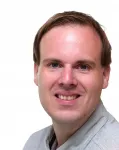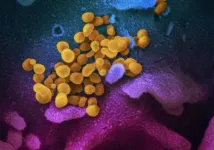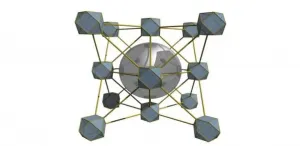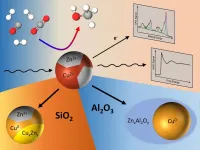INFORMATION:
Mutant proteins from SARS-CoV-2 block T cells' ability to recognize and kill infected cells
2021-03-04
(Press-News.org) A deep sequencing study of 747 SARS-CoV-2 virus isolates has revealed mutant peptides derived from the virus that cannot effectively bind to critical proteins on the surface of infected cells and, in turn, hamper activation of CD8+ killer T cells that recognize and destroy these infected cells. These peptides, the authors say, represent one way the coronavirus subverts killer T cell responses and stymies immunity in the host. Their results may be of particular importance for SARS-CoV-2 subunit vaccines, such as the RNA vaccines currently in use, which induce responses against a limited number of viral peptides presented on T cells; such vaccines may be at risk of stunted efficacy if any of these target peptides are mutated in emerging virus variants. However, because T cells can broadly recognize an array of epitopes, it remains to be determined just how mutations in single epitopes truly affect viral control. Killer T cells kill infected cells upon recognition of viral epitopes, which are displayed on the surface of infected cells by class I major histocompatibility complex (MHC-I) proteins, or human leukocyte antigen (HLA) proteins as they're called in humans. Certain positions in these epitopes are critical for HLA-I presentation, and mutations in these regions might interfere with the epitope binding to the HLA. Benedikt Agerer and colleagues identified mutations in killer T cell epitopes from SARS-CoV-2 after deep sequencing 747 SARS-CoV-2 virus isolates. They confirmed that these mutant peptides could not effectively bind to HLA protein in a cell-free, in vitro assay. When exposed to killer T cells isolated from HLA-matched COVID-19 patients, reduced binding of mutant peptides to HLA-I decreased proliferation of T cells, stunted production of inflammatory factors such as IFN-γ, and interrupted the overall cell-killing activity of the killer T cells. In future work, the authors aim to address how these "escape" mutations are maintained during transmission between individuals with differing HLA subtypes and how viruses carrying epitope mutations affect disease severity.
ELSE PRESS RELEASES FROM THIS DATE:
Do known drugs help against SARS-coronavirus-2?
2021-03-04
There are no therapeutics available that have been developed for COVID-19 treatment. Repurposing of already available medication for COVID-19 therapy is an attractive option to shorten the road to treatment development. The drug Camostat could be suitable. Camostat exerts antiviral activity by blocking the protease TMPRSS2, which is used by SARS-CoV-2 for entry into cells. However, it was previously unknown whether SARS-CoV-2 can use TMPRSS2-related proteases for cell entry and whether these proteases can be blocked by Camostat. Moreover, it was unclear whether metabolization of Camostat interferes with antiviral activity. An international team of researchers around Markus Hoffmann and Stefan Pöhlmann ...
March science snapshots
2021-03-04
Solving a Genetic Mystery at the Heart of the COVID-19 Pandemic
As the COVID-19 pandemic enters its second year, scientists are still working to understand how the new strain of coronavirus evolved, and how it became so much more dangerous than other coronaviruses, which humans have been living alongside for millennia.
Virologists and epidemiologists worldwide have speculated for months that a protein called ORF8 likely holds the answer, and a recent study by Berkeley Lab scientists has helped confirm this hypothesis.
In a paper published in mBio, lead author Russell Neches and his colleagues ...
Porous crystal guides reaction to transform CO2
2021-03-04
By embedding a silver catalyst inside a porous crystal, KAUST researchers have improved a chemical reaction that converts carbon dioxide (CO2) into carbon monoxide (CO), which is a useful feedstock for the chemical industry.
Carbon monoxide is a building block for producing hydrocarbon fuels, and many researchers are searching for ways to produce it from CO2, a greenhouse gas emitted by burning fossil fuels. One strategy involves using electricity and a catalyst to drive a so-called CO2 reduction reaction. But this reaction typically produces a variety of other products, including methane, methanol and ethylene. Separating these products significantly raises the cost of the process, ...
SUTD study uncovers how big droughts in the Greater Mekong trigger CO2 emission bursts
2021-03-04
A study on big droughts in the Greater Mekong region revealed findings that can help reduce the carbon footprint of power systems while providing insights into better designed and more sustainable power plants.
The study, titled 'The Greater Mekong's climate-water-energy nexus: how ENSO-triggered regional droughts affect power supply and CO2 emissions', was published by researchers from the Singapore University of Technology and Design (SUTD) and the University of California, Santa Barbara, in the journal Earth's Future.
Known as an important means to support economic growth in Southeast Asia, the hydropower resources of the Mekong River Basin have been largely exploited by the riparian countries. The researchers ...
Zinc oxide: key component for the methanol synthesis reaction over copper catalysts
2021-03-04
The current commercial production of methanol through the hydrogenation of the green-house gas CO2 relies on a catalyst consisting of copper, zinc oxide and aluminum oxide. Even though this catalyst has been used for many decades in the chemical industry, unknowns still remain. A team of researchers from the Interface Science Department of the Fritz-Haber-Institute of the Max Planck Society, the Ruhr-University Bochum, Stanford Linear Accelerator Center (SLAC), FZ Juelich and Brookhaven National Laboratory have now elucidated the origin of intriguing catalytic activity and selectivity trends of complex nanocatalysts ...
Cutting off stealthy interlopers: a framework for secure cyber-physical systems
2021-03-04
In 2015, hackers infiltrated the corporate network of Ukraine's power grid and injected malicious software, which caused a massive power outage. Such cyberattacks, along with the dangers to society that they represent, could become more common as the number of cyber-physical systems (CPS) increases.
A CPS is any system controlled by a network involving physical elements that tangibly interact with the material world. CPSs are incredibly common in industries, especially those integrating robotics or similar automated machinery to the production line. However, as CPSs make their way into societal infrastructures such as public transport and energy management, it becomes even more important to ...
Large number of COVID-19 survivors will experience cognitive complications
2021-03-04
A research review led by Oxford Brookes University has found a large proportion of COVID-19 survivors will be affected by neuropsychiatric and cognitive complications.
Psychologists at Oxford Brookes University and a psychiatrist from Oxford Health NHS Foundation Trust, evaluated published research papers in order to understand more about the possible effects of the SARS-COV-2 infection on the brain, and the extent people can expect to experience short and long-term mental health issues.
Patients experienced a range of psychiatric problems
The study found that in the short term, a wide range of neuropsychiatric problems were reported. In one examined study, 95% of clinically ...
University of Limerick, Ireland, research identifies secrets of Fantasy Premier League success
2021-03-04
As millions of Fantasy Premier League players mull over a decision whether to start Bruno Fernandes or Mohamed Salah in their teams this weekend, new research by the University of Limerick in Ireland has unlocked the secrets of the popular online game.
A new study by a team of researchers at UL has identified the underlying tactics used by the top-ranked competitors among the seven million players of Fantasy Premier League (FPL), the official - and world's largest - fantasy football game of the English Premier League.
Joseph O'Brien, Professor James Gleeson, and Dr David O'Sullivan, based within the ...
Legal wildlife trade needs monitoring to reduce risk of a new pandemic
2021-03-04
With three out of four newly emerging infectious human diseases originating in animals*, there is an urgent need to monitor the legal trade in wildlife, according to new research by Vincent Nijman, Professor in Anthropology at Oxford Brookes University.
Professor Nijman, who has been involved in monitoring and regulating the legal wildlife trade for over two decades, said: "Covid-19 more than anything else has put a spotlight on emerging infectious diseases and how this is linked to the trade in wild animals. Few people are aware of its scale. With literally hundreds of millions ...
Protein discovery could help enable eco-friendly fungicides
2021-03-04
New research reveals an essential step in scientists' quest to create targeted, more eco-friendly fungicides that protect food crops.
Scientists have known for decades that biological cells manufacture tiny, round structures called extracellular vesicles. However, their pivotal roles in communication between invading microorganisms and their hosts were recognized only recently.
UC Riverside geneticist Hailing Jin and her team found plants use these vesicles to launch RNA molecules at fungal invaders, suppressing the genes that make the fungi dangerous.
"These vesicles shuttle small RNAs between cells, like tiny Trojan horses with weapons hidden inside," said Jin, a professor of genetics and the Cy Mouradick Chair in the Department of Plant Pathology and Microbiology. ...







